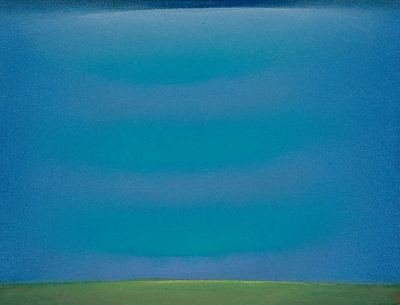Painter Robert Jessup contributed his own better one as a comment.
I think that I met Mike Dailey in 1972 when I took my first Beginning Drawing class from him at the University of Washington. I took many more classes from him, and he became my unofficial guidance counselor during my undergraduate voyage to my BFA in painting.
I went to the University of Iowa for my MFA because of Mike. (Mike introduced me to the work of Pierre Bonnard!) Actually, all the things I really learned about painting, all the things that I came to value as an artist and hold close to my painter’s heart, I learned from Mike. He was not only my mentor, but my role model as an artist, teacher, friend, and human being. He was the example I could point to, the touchstone, the way one should be. I have never known anyone as generous with himself as was Mike. Or as loyal. Or as wise.
Mike was a great artist. And not just because he made great
paintings. That was almost beside the point for him. What mattered was
going into the studio every day and trying to find IT: that precise but
ineffable coming together of weight and atmosphere, of pressure and
release, of mood and time and memory. All of it pursued through the
dogged manipulation of field, edge, and color. Always color. Mike was
one of the greatest colorists in the history of painting. (Seattle, you
really should know this). The only painter I can think of whose color
harmonies are as complex and ingenious as Mike’s is Bonnard.I
remember when Mike had to change from his beloved oils to acrylic. (Oh,
how he HATED the acrylic paint then!) What was amazing is that I never
thought he really missed a beat. Yes, some things were lost, but he
found new ways to find the IT that he needed to find. He began to make
his paintings horizontal (I remember how curious it seemed to me when I
heard him say in the mid seventies how he wished he could make
horizontal paintings but that he never could seem to do it. I thought
at the time, hmm, you just stretch a horizontal canvas, but he was
talking about something much more complex, about how a painting of true
authenticity and conviction can only be earned, not contrived: another
lesson I learned from Mike.)

Eventually,
his paintings found very architectonic rhythms. In later years, the
incredible color fields would bump and dance with each other–they
reminded me of the sort of gallumphing rhythms found in the music of
Brahms. Rugged, strong, yet slightly mischievous.Mike lived
with the slow deterioration from MS for over thirty years, but I never
knew his spirit to break. Many were the times that he would buck me up
in the face of my petty complaints, always finding a reason to be
optimistic. When we got together, we would of course grouse about
various things, but always, in the end with Mike, there was a
fundamental optimism and gratitude for the possibilities presented and
the great good fortune we had to be painters.Mike lived a
life full of grace and dignity, wisdom, humor, and love. I am so very
grateful for all that I learned from him, and for the friendship that
we shared. I will miss him more than I can say.
– Robert Jessup, Professor College of Visual Arts and Design, University of North Texas Denton




I very much appreciate this remembrance. It is close to my own feelings about Mike.
Uncle Mike was also an extremely compassionate and understanding individual. I have a neuropsych disability, and he was sensitive about it, especially when others demanded the impossible from me!